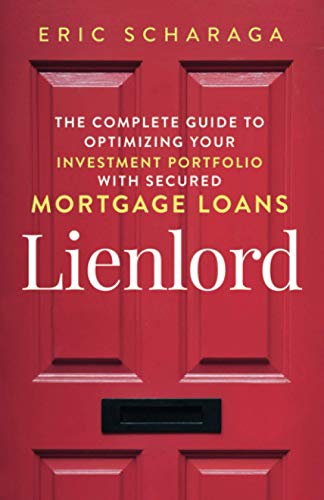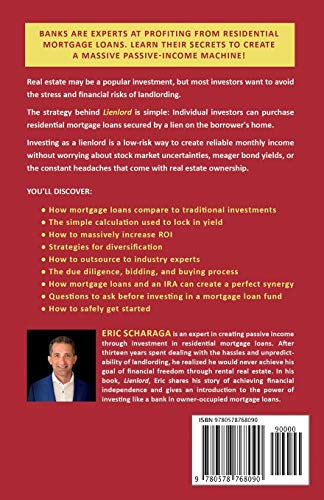Servicios al cliente
Sobre nosotros
Copyright © 2025 Desertcart Holdings Limited
Desert Online General Trading LLC
Dubai, United Arab Emirates



Full description not available
A**R
Definitely NOT "The Complete Guide"
This book was very disappointing. I bought it because it was very highly rated. I was excited to read all about how to invest in mortgage liens. After reading it I am no closer to being able to make an investment than I was after reading a quick google search about mortgage liens.The first half of the book talks about how stocks, bonds, funds, real estate and any other investment vehicle is not as good of an investment as mortgage liens.The second half that talks about mortgage liens basically says Step 1 Find mortgage liens (can't tell you where to find them because they are found through connections) moving on. Step 2 Due diligence, the only somewhat beneficial section of the book. It is surface level but at least covers some things to look for. Step 4 Bid based off of the numbers that work for you. Step 5 Sign 2 pieces of paper and you are done....Congrats!Save your money and just read a couple Google searches.
A**W
Great Introduction to Note Investing
This book is highly recommended for those who want to learn about note investing. It tells you everything from what a note is to how the industry works, the steps involved in analyzing and buying notes, the different ways of investing in notes, and how notes compare to a variety of other investment options.For some context: I am a new note investor and I've spoken with the author a few times.(1) I've read a good number of books on note investing, and here is what struck me about this one:*This book is the same length as most others in this space (150 to 180 pages), but compared to most it comes across as more thorough in the scope of what it covers and as a more serious effort.*The book does not oversell itself. Unlike some note investing books, this one does not pretend to be the only resource you will need before making your first investment. The author makes it clear that further research is required.*This book goes into detail regarding how note investing compares to other forms of investing (stocks, bonds, etc.) and there is a particular focus on comparing note investing to being a landlord (which was the author's previous investment focus). The latter can be helpful to readers because many note investors are former landlords who grew tired of the hassles inherent in that space (i.e. tenants, toilets, and termites).*Many note investing books don’t sufficiently address the critical due diligence process, but this book goes into far more detail. It does not pretend to be a complete research "checklist," but it provides insight into the type of detailed work that is involved.*The book addresses the process of bidding on notes – something I don't remember being addressed in most other books.(2) What I did not like about the book:It does not address the returns one can expect when investing in different types of notes (e.g. performing vs. non-performing first mortgages, performing vs. non-performing second mortgages) throughout the business cycle (the good times, the bad times, and the overall average) or where the industry currently stands.(3) Something to keep in mindNote investing covers a wide variety of specialties, and understandably the book does not cover them equally. While most of the information in this book is applicable to note investing in general, it seemed to focus most heavily on performing first mortgages (i.e. generally the borrower's largest mortgage, where the borrower is consistently making their mortgage payments). This is not a bad thing – it's just something to note depending on your focus within the note space.Overall, one of the best books I've read on the topic.
S**6
Solid info for the novice real estate investor!
If you are considering diversifying your portfolio to include real estate, mortgage investment is a dynamite way to do it, and this extremely well-written book walks you through it. The author is clearly knowledgeable and uses his years of landlord experience to demystify an at times highly confusing topic. I suggest reading this book first, then search out others like it for additional insight. Do your homework and learn as much as you can--and always, ALWAYS consult a professional financial advisor before making any major changes/diversifications to your portfolio. There is no such thing as "too much" information.
C**B
Mortgage notes explained in layman’s terms. Recommended.
I’ve picked up a few books on mortgage notes recently to gain a basic understanding of this wealth building strategy and Lienlord has been a really helpful one. I’m familiar with traditional real estate strategies, so this approach was new to me and eye-opening. The author shares some of their personal story and path to investing in mortgage notes, which helped me see the possibilities of anyone of us following the same path. It covers all the important topics from calculating yield to volatility to bidding on much more. If you need a strong primer on this investment tool, this book won’t fail you.
R**A
A well-researched overview
The book is about income from investing in the security of real estate without having to own property.It goes beyond traditional investment styles that are unpredictable. I am new in this field, and before deciding, I always bear in mind, “Never invest in a business you cannot understand.”Eric Scharaga was a teacher and real estate investor before becoming a full-time mortgage loan investor. He did great and long research before writing this book. The glossary at the end of the book is helpful when you don’t understand any term.
C**.
Great Start for Due Diligence
The book did a great job of letting the reader know they types of things to consider when doing your due diligence, both prior to making an offer and afterward. It's not intended to be comprehensive, but it's gets the mind thinking. It would not be difficult to gain access to typical due diligence documents and use the top-level due diligence information to better understand the documents... as practice.As a real estate investor, I understand ROI, cap rate, NOI, but in note investing, I had not yet understood "yield." He explained this simply, with great examples and showed how to use 4 buttons on a financial calculator to do all of the calculations an investor would need to understand their "yield"
M**A
Put it into action
As a woman, I have no idea what a mortgage about, and I see this book at a reasonable price, which made me buy it. This book is helpful in many ways. The author is not only sharing information about a mortgage but also share his own experience. This helped me to see that I can follow this path too. It covers all the essential topics. If you want to diversify your portfolio to include real estate, mortgage investment, this book will be of great help. I dont like how he cited the references, he just pasted links.
Trustpilot
Hace 2 semanas
Hace 3 semanas